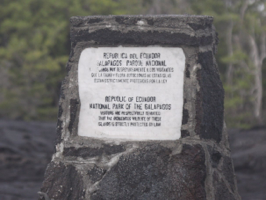S. and I announced our intention to take a trip with each of our eight grandchildren without considering the considerable consequences. Chief among these consequences is the curious choice of places on this planet that would be suitable for a multi-generational ten day outing and selected to visit. It’s now lost in the mists of my declining memory whether our darling granddaughter Annabel suggested the Galapagos Islands or if I suggested that she might want to suggest the Galapagos. In any case, in April of 2010 we found ourselves breathing the lofty airs of Quito, Ecuador and frolicking in the not so warm waters of the Humboldt Current surrounding the Galapagos.
I suspect at some point I will be compelled to write at more length a piece which will be entitled “Lessons Learned While Traveling with Your Twelve Year Old Grandchild”. It will be revealing and entertaining I assure you. One chapter of this missive will surely be “Three Reasons a Sixty Six Year Old Grandfather Should Not Snorkle in the Open Sea with His Twelve Year Old Very Athletic Granddaughter”. Notwithstanding the perils implied, I can say with certainty that the benefits overwhelm the effort required.
The Galapagos, as I’m sure you all know, is a province of Ecuador but a prized possession of the world. That is to say that although the Ecuadorian government administers the almost one hundred islands that make up the Galapagos archipelago, it is esteemed by most because of the laboratory of flora and fauna that exists therein due to a confluence of factors. And, of course, due to the fact that none other than Mr. Charles Robert Darwin (1809-1882), an English natural scientist most noted for a book I now have in front of me which rocked both the secular and religious worlds when it was published in 1859. The Origin of the Species, which really didn’t become Origin of the Species until some clever marketing type weighed in on the 6th Edition in 1872. It was originally entitled “On the Origin of the Species by Means of Natural Selection, or the Preservation of Favorable Races in the Struggle for Life. You now see why we suffer the marketing type person.
I must admit that although I’ve had a very nice edition of this tome in my library for some time, and I’ve always meant to read it front to back, but I admit I have not. Nor, I suspect, have you or most others. I have, however, read enough of it and the editorial comment about it to understand why the Church of England was really PO’ed when it came to light and got a lot of press in the mid 19th century. For your convenience, I’ve boiled down his lifetime of work into what I think is a perfectly readable and understandable couple of sentences. Here is my version of the essence of what most refer to as Darwin’s Theory.
“Individuals (both human and animal) less suited to the environment are less likely to survive very long and consequently won’t reproduce very well and vice-versa. Those that do survive are more likely to leave their imprint on future generations. This is now called “The Theory of Natural Selection”.
Ok, I know that Darwin posited a bunch of other stuff too, but it’s really complicated and really controversial, so I’m gonna avoid it for now. I’ll bet you are relieved by this decision as well. It’s only now occurred to me that the principles of natural selection and the idea of evolution of the species go hand in glove so to speak. For example, in that there is no source of water in the Galapagos other than rainfall (no underground sources, springs, etc) all of the endemic species of the Galapagos adapted, or evolved, if you will, to a physiology that did not require the presence of year round fresh water. It’s naturally explicit that prior to the colonization of these remote isles, all of life was about a fight for water first, then food. The rule was adapt or die. A very real survival of the fittest.
Perhaps the best known example of these principles is evident in the thirteen variations of Finches (they are really Tanagers, but I won’t split hairs or feathers on this point) that have become known as Darwin Finches. Here’s why they are important. A few million years ago a single finch migrated to the Galapagos from Central or South America, most likely assisted by some extraordinary winds. Over the ensuing millenia, a process of speciation occurred as the descendants of the original finch adapted to the most prevalent food sources. All of these Finches share striking similarity in size, coloration and habits, but are differentiated by the size a shape of their beaks. To wit: the Large Ground Finch has a rather stubby and very strong beak, the better to crack the seeds upon which he feeds, but the Sharp-beaked Ground Finch which feeds principally on grubs and other insects has, as you might guess, a longer, curved beak which facilitates his search for his food of choice. The others of this group of Finches are likewise differentiated by slight variations in their beaks. In Darwin’s memoirs, written long after his Beagle voyage and visit to the Galapagos commented thusly, “one might really fancy that, from an original paucity of birds in this archipelago, one species had been taken and modified for different ends”. Get it. They adapted (evolved) so they could eat what was around. Kind of like me and double bacon cheeseburgers and my oversized mouth.
I think I sense more than a few yawns amongst my limited but highly intelligent readership, and even one faint moan of “so what”. Well, my “so what” is that from these few volcanic islands, more than nine hundred miles from the mainland of South America, and the discovery and study of thirteen similar but different birds found there, Darwin and others laid the foundation of our understanding of how we got to be and what we are. It certainly makes more sense to me than the Garden of Eden thing. The rib grabbing always put me off.
Apropos of possibly nothing, I offer another Galapagos oddity. Although there are one hundred thirty species of hummingbirds identified in Ecuador, there are none in the Galapagos. Hmmm? Too far at sea? Nah. Hummers annually fly over the Gulf of Mexico to get the the feeders I put out at our farm. The answer…..there are no blooming flowers in the Galapagos. No flowers, no hummers. Surely you recollect that hummers feed on the nectar of flowering plants and in turn pollinate future generations of flowers. The thing that puzzles me, however, is the chicken or the egg thing. Are there no flowers because there are no hummingbirds or are there no hummingbirds because there are no flowers. You figure it out.
I wanted to tell you about the Blue Footed Boobies and the Flightless Cormorants, but I’ll have mercy and save that for another day and another posting. I will give you fair warning.



